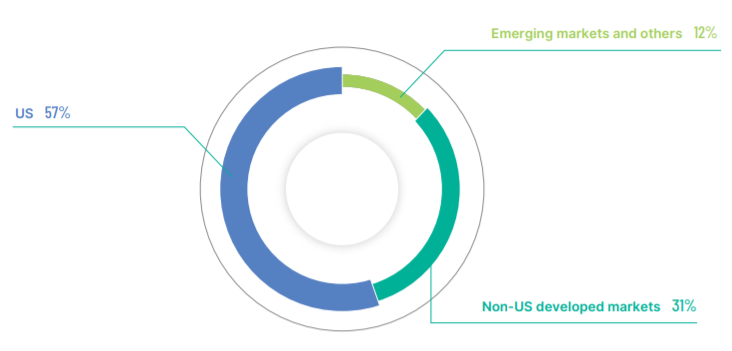Investments
As a large, long-term institutional investor, CIC has always attached great importance to constructing a simple, transparent, and resilient portfolio and undertaken continuous efforts to optimize asset allocation and portfolio management. CIC focuses on asset allocation based on four principles: (a) compliance with the long-term return objectives and risk tolerance approved by the Board of Directors; (b) alignment with CIC's characteristics and investment principles and philosophies; (c) based on academic research and the practices of other investment institutions; and (d) continuous optimization and improvement through investment practice.
CIC adopts the Reference Portfolio framework, which consists of public market equities and fixed-income products obtained through passive low-cost products. The framework also included the Three-year Policy Portfolio, the Annual Policy Portfolio/Target Portfolio, and the Actual Portfolio. The Reference Portfolio serves as the anchor for the risk target of the overall portfolio and the benchmark for medium- to long-term relative performance. The Three-year Policy Portfolio makes allocations to other asset classes and active strategies and is expected to outperform the Reference Portfolio with a higher risk-return profile. The Annual Policy Portfolio/Target Portfolio takes into account the progress of alternative investment and short-term market views. The framework has improved the transparency and effectiveness of asset allocation and overall portfolio management. At present, many sovereign wealth funds, pension funds, and peer institutions in other countries are using the Reference Portfolio framework.
CIC invests in a wide range of financial products globally, including public equity, fixed income, alternative assets and cash and others. Public equity refers to equity investment in listed companies. Fixed income refers to bonds, including sovereign, corporate, and agency bonds. Alternative assets include hedge funds, risk parity investments, industry-wide direct investments, industry-wide private equity, private credit, resources/commodities, real estate and infrastructure. Cash and others includes cash, overnight deposits, and US Treasury bills.
In 2011, the Board of Directors extended our investment horizon to 10 years and adopted rolling annualized return as as a key indicator for evaluating our performance.
-
Global Investment Portfolio Distribution
As of 31 December 2020
Internally Managed Assets versus Externally Managed Assets
As of 31 December 2020
In 2020, the COVID-19 pandemic plunged the global economy into a severe recession, triggering sharp slumps in capital markets on a scale rarely seen. International capital markets were characterized by lower returns, higher volatility, and greater divergence across regions and sectors. During the same period, cross-border investments were subjected to tighter screening, presenting sovereign wealth funds with significant challenges in deploying their capital.
CIC continued to operate on an international, market-driven, and professional basis, taking sound, prudent investment decisions in line with its investment philosophies and risk tolerance limits. The company fully tapped into the Information Superhighway mechanism and strengthened linkages between research and investment operations in order to mount a coordinated response at the portfolio, strategy, and project levels.
To ensure the orderly operation of the total portfolio and reduce its volatility in this crisis-impacted market, CIC undertook in-depth analyses of the macroeconomic and market environments, continuously monitored its assets, and ran stress tests on the total portfolio. We devised contingency plans for proactive portfolio adjustment, dynamically optimized liquidity reserves, and made timely revisions to rebalancing policies. At the height of market volatility, the company remained consistent in its strategic focus and positioning as a long-term investor and ensured strict adherence to defined risk tolerances. This approach ensured investment and management effectiveness, and allowed for much valuable experience to be gained.
The pandemic has accelerated the ongoing technology revolution and the pace of industrial transformation. New technologies, industries, business formats, and models have rapidly emerged and flourished. To better position itself to capitalize on new opportunities in the post-pandemic era, CIC optimized its use of leverage across the total portfolio; revised its approach to currency exposure management; made improvements to its strategy composition, benchmarks, and financing portfolio; and launched an Environmental, Social, and Governance (ESG) investment policy framework. These steps have improved the construction and management of the total portfolio. CIC also closely tracked market trends to seize opportunities to exploit market mispricing, and continued to optimize its investment footprint in public markets while steadily stepping up investments in private markets.
Public Market Investment
Improvements in Investment Composition and Efficiency
Against the backdrop of extreme volatility in global financial markets, CIC took proactive measures to respond to market conditions while continuing to deploy capital through a coordinated mix of proprietary and mandated investments. The company optimized its footprint in public markets, made orderly adjustments to its equity and fixed income portfolios, built up a strong sector-based research framework, and increased its exposure to technology and healthcare. CIC also refined its strategy construction and manager allocation while exploring new investment approaches and seizing opportunities derived from market mispricing. CIC’s proprietary investment portfolio has been actively developed in line with the company’s overall strategy, realizing competitive advantages and economies of scale. Our proprietary investment capabilities have continued to strengthen as a result of ongoing efforts to build our talent pipeline. We have also made significant headway in the development of digital information management systems for our public market investment activities.
-
Fixed Income in Global Portfolio
As of 31 December 2020
Public Equity in Global Portfolio by Region
As of 31 December 2020
Public Equity in Global Portfolio by Sector
As of 31 December 2018
Private Market Investment
Logging Record-High Commitments While Continuing to Deliver on Quality
CIC has worked diligently to overcome the challenges of COVID-19. We reviewed all existing investments and re-assessed those still in progress. By capitalizing on market corrections, closely monitoring allocation targets, and placing equal weight on quality and scale, CIC steadily ramped up its private market investments. In 2020, the company not only achieved positive growth against headwinds in private market investments, but registered a new record high in total commitments and made breakthroughs in several sectors and regions. In addition, CIC expanded its network of and commitments to high-quality general partners (GPs), strengthened its relationships with external managers, and developed new cooperative investment structures.
Private equity and private credit: Despite the market downturn and resulting portfolio volatility, CIC made timely allocations to high-quality funds, added more top-tier GPs, and expanded its pool of GPs. While fine-tuning our fund investments, we proactively mined co-investment opportunities to capitalize on market volatility. We also made further inroads in the secondary market, building on our maturing industry-wide private equity portfolio. We took advantage of post-pandemic investment opportunities by allocating to opportunistic and distressed credit assets, and ramped up our investment in technology-focused private equity funds.
Real estate: Real estate continued to serve as a defensive asset class and shield against inflation. CIC further built up its portfolio of core assets in line with our analysis of industry trends and market cycles. We took stock of the pandemic’s impact on different real estate business models in terms of short-term trends and the post-pandemic outlook. CIC adopted a more granular approach to portfolio management and developed multidimensional analytical models to better monitor portfolio performance. In terms of strategy, CIC sought to capitalize on investment opportunities arising out of the pandemic, with a focus on sub-sectors that align with long-term trends, show pan-cyclical resilience, and cushion against volatility.
CIC Capital's direct investment: CIC Capital has expanded its footprint and established a comprehensive monitoring mechanism to review the audit reports of investee companies. Its overseas investment model is built on a matrix that combines key geographies and sectors. In 2019, CIC Capital approved 30 investments, with a total commitment of approximately USD 5.8 billion covering infrastructure, energy, TMT, consumer, healthcare, manufacturing, agriculture and other sectors. Tailor-made solutions and post-investment management plans were implemented for several legacy deals, based on the local market environment and project performance. By working with stakeholders and capitalizing on market windows, CIC Capital exited projects successfully and secured returns.
Infrastructure:CIC achieved high effectiveness in both post-investment management and new investments thanks to our close tracking of market dynamics. We assessed the performance of different categories of infrastructure projects during the pandemic by analyzing yield and quality, liquidity, and key indicators, as well as conducting stress tests. Based on this assessment, we took proactive steps to manage projects disproportionately impacted by the pandemic. CIC also carried out in-depth sectoral research, fine-tuned its strategy, and rebalanced its allocations across sectors and regions to diversify portfolio risk. In particular, we scaled up our investments in the Asia Pacific region, as well as in the digital infrastructure, power, renewable energy, and public utilities sectors.
Energy and Resources:CIC closely monitored its assets, stepped up post-investment management, and took precautions against risks. In a low oil-price environment, we maintained appropriate exposure to commodities through investments in funds; sought investment opportunities arising from energy transition and environmental trends; increased our exposure to renewable energy; and recruited high-caliber managers with relevant industry expertise.
Industry-wide investment: CIC continued to deepen its presence in sectors such as TMT (technology, media, and telecom), healthcare, consumer services, and high-end manufacturing, with a focus on sub-sectors including supply chains, innovative pharmaceuticals, software, and education. We created value by connecting portfolio companies with opportunities in China. We also applied strict controls on portfolio risks, monitored financial and operational risks in portfolio companies, and stepped up our communication with and management of existing funds and portfolio companies. These measures enabled us to identify potential risks and put contingency plans in place.
Agriculture:CIC has actively built long-term partnerships with top-tier industry investment platforms at home and abroad, and has comprehensively strengthened its investment capacities and resource synergies through a variety of agile investment approaches. Based on a multidimensional review of our agrifood portfolio, the company has deployed a whole-value-chain investment strategy. On this basis, we have actively sought out potential investment opportunities and partners in key areas, leveraging a research-driven approach.
New multilateral and bilateral funds: Four new bilateral funds—the France-China Cooperation Fund, UK-China Industrial Cooperation Fund, Japan-China Industrial Cooperation Fund, and Italy-China Industrial Cooperation Fund— have been rolled out in succession and have made strong progress in closing deals in priority sectors. CIC’s efforts to connect our portfolio companies with the Chinese market and industry partners have realized significant value-creation milestones.
Overseas Offices:
Extend our Footprint across the Globe and Deepen our International Partnerships
CIC International (Hong Kong) managed its public market portfolios in accordance with investment disciplines and prudently managed portfolio risks against market challenges. It also took advantage of its presence in Hong Kong to monitor closely market dynamics in the region and across the globe and to engage in active exchanges and interactions with peer institutions. With a focus on the Guangdong-Hong Kong-Macau Greater Bay Area and growing reach to the Asia Pacific, CIC International (Hong Kong) explores private market investments and synergizes with headquarters departments in deal sourcing and post-investment management.
The Representative Office in New York is well positioned to leverage on the resources and network of this international financial center to deepen our research on the regional economy, policies, financial markets and regulatory development. Our New York office has built business partnerships to help source deal opportunities and enhance business cooperation. In addition, our New York office provides valuable local support for our investments across the Americas by engaging in substantial portfolio management while collaborating with our investment teams of the headquarters. Our New York office took on more tasks to help manage our investments when business travels were restricted due to COVID-19. It played an important role in maintaining local business relationships and communications.
CIC is a long-term institutional investor with a 10-year investment horizon that applies annualized rolling returns as its key performance metric.
In 2020, CIC’s overseas portfolio posted a net annual return of 14.07%. As at December 31, 2020, CIC’s cumulative 10-year net return stood at 6.82%, and its annualized cumulative net return since inception stood at 6.71%. (All the above figures are calculated on a USD value basis).
Investment Performance on the Global Portfolio (all measured in US$)
| Year | Net cumulative annualized return | Net annual return |
|---|---|---|
| 2008a | -2.1% | -2.1% |
| 2009 | 4.1% | 11.7% |
| 2014 | 5.66% | 5.47% |
| 2015 | 4.58% | -2.96% |
| 2016 | 4.76% | 6.22% |
| 2010 | 6.4% | 11.7% |
| 2011 | 3.8% | -4.3% |
| 2012 | 5.02% | 10.60% |
| 2013 | 5.70% | 9.33% |
| 2017 | 5.94% | 17.59% |
| 2018 | 5.18% | -2.35% |
| 2019 | 6.13% | 17.41% |
| 2020 | 6.71% | 14.07% |
a. Net cumulative annualized returns and the annual return for 2008 are calculated since inception on 29 September 2007.

